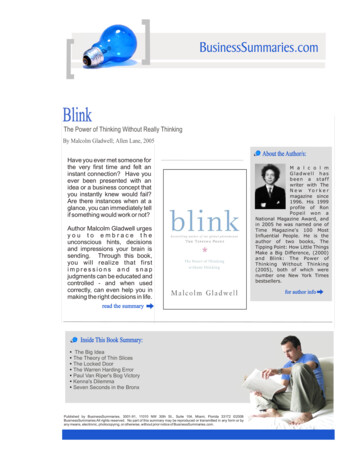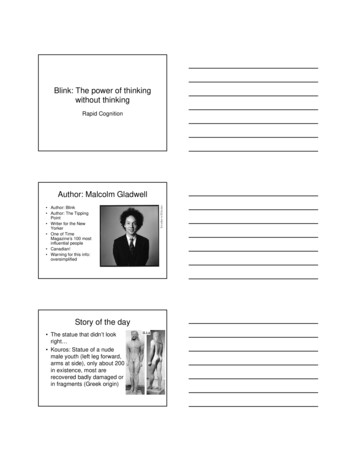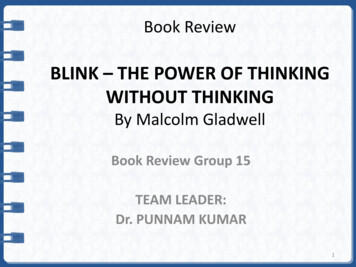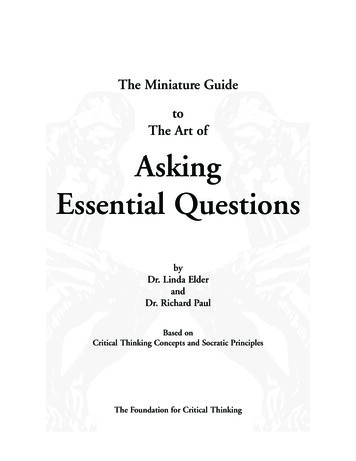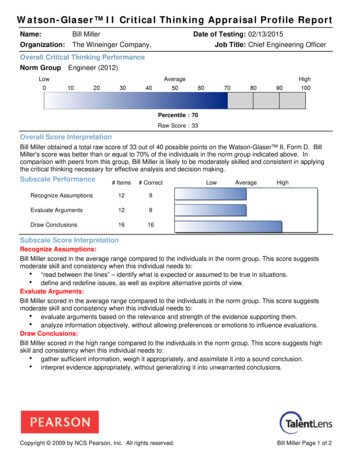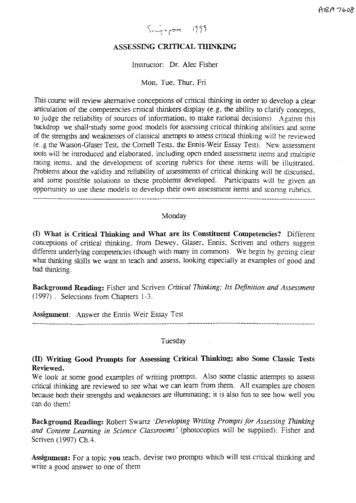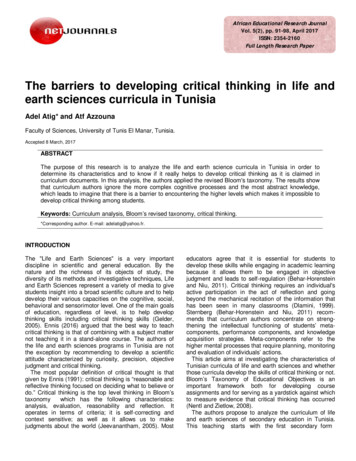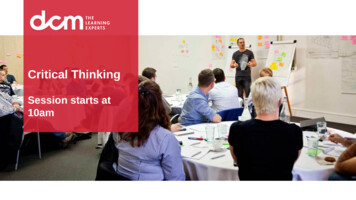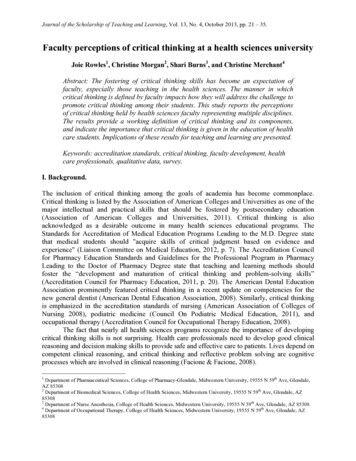
Transcription
Journal of the Scholarship of Teaching and Learning, Vol. 13, No. 4, October 2013, pp. 21 – 35.Faculty perceptions of critical thinking at a health sciences universityJoie Rowles1, Christine Morgan2, Shari Burns3, and Christine Merchant4Abstract: The fostering of critical thinking skills has become an expectation offaculty, especially those teaching in the health sciences. The manner in whichcritical thinking is defined by faculty impacts how they will address the challenge topromote critical thinking among their students. This study reports the perceptionsof critical thinking held by health sciences faculty representing multiple disciplines.The results provide a working definition of critical thinking and its components,and indicate the importance that critical thinking is given in the education of healthcare students. Implications of these results for teaching and learning are presented.Keywords: accreditation standards, critical thinking, faculty development, healthcare professionals, qualitative data, survey.I. Background.The inclusion of critical thinking among the goals of academia has become commonplace.Critical thinking is listed by the Association of American Colleges and Universities as one of themajor intellectual and practical skills that should be fostered by postsecondary education(Association of American Colleges and Universities, 2011). Critical thinking is alsoacknowledged as a desirable outcome in many health sciences educational programs. TheStandards for Accreditation of Medical Education Programs Leading to the M.D. Degree statethat medical students should "acquire skills of critical judgment based on evidence andexperience" (Liaison Committee on Medical Education, 2012, p. 7). The Accreditation Councilfor Pharmacy Education Standards and Guidelines for the Professional Program in PharmacyLeading to the Doctor of Pharmacy Degree state that teaching and learning methods shouldfoster the “development and maturation of critical thinking and problem-solving skills”(Accreditation Council for Pharmacy Education, 2011, p. 20). The American Dental EducationAssociation prominently featured critical thinking in a recent update on competencies for thenew general dentist (American Dental Education Association, 2008). Similarly, critical thinkingis emphasized in the accreditation standards of nursing (American Association of Colleges ofNursing 2008), podiatric medicine (Council On Podiatric Medical Education, 2011), andoccupational therapy (Accreditation Council for Occupational Therapy Education, 2008).The fact that nearly all health sciences programs recognize the importance of developingcritical thinking skills is not surprising. Health care professionals need to develop good clinicalreasoning and decision making skills to provide safe and effective care to patients. Lives depend oncompetent clinical reasoning, and critical thinking and reflective problem solving are cognitiveprocesses which are involved in clinical reasoning (Facione & Facione, 2008).1Department of Pharmaceutical Sciences, College of Pharmacy-Glendale, Midwestern University, 19555 N 59th Ave, Glendale,AZ 853082Department of Biomedical Sciences, College of Health Sciences, Midwestern University, 19555 N 59th Ave, Glendale, AZ853083Department of Nurse Anesthesia, College of Health Sciences, Midwestern University, 19555 N 59th Ave, Glendale, AZ 853084Department of Occupational Therapy, College of Health Sciences, Midwestern University, 19555 N 59th Ave, Glendale, AZ85308
Rowles, J., Morgan, C., Burns, S., & Merchant, C.While health sciences programs, along with many other higher education programs,recognize the importance of critical thinking, unless there is clarity as to what critical thinkingactually is it will be difficult to teach to students (Hatcher, 2000). Lack of agreement on thedefinition of critical thinking has been noted as a reason for the difficulty in teaching clinicalcritical thinking skills in nursing students (Allen, Rubenfeld, & Scheffer, 2004). Similarly, a clearunderstanding of the components or characteristics of critical thinking is needed to design properassessments to measure student learning outcomes. Several educators assert that without a clearconceptualization over what constitutes critical thinking, valid assessment will remainproblematic (Appleby, 2005; Gordon, 2000; Hatcher, 2000; Kennedy, Fisher, & Ennis, 1991).How faculty define critical thinking is therefore key to how it is taught and subsequently to howhealth science students apply it in the learning of clinical reasoning skills.The literature provides various definitions of critical thinking from researchers inphilosophy, education or critical thinking. Some nurse researchers conclude that the largenumber of reported definitions and attributes of critical thinking serve to decrease the likelihoodof reaching a consensus (Turner, 2005). However, Halpern (1999) has stated that the variousdefinitions of critical thinking include the same underlying principles. Others have alsorecognized commonalities in the many definitions and attributes associated with the concept ofcritical thinking (Jones, 2010). A review of the literature indicates that most researchers nowagree that general principles of critical thinking exist, that these principles transcend subjectmatter and can be applied to more than a single subject (ten Dam & Volman, 2004).The American Philosophical Association published a qualitative study that utilized apanel of experts from various disciplines to come to a consensus for critical thinking utilizing theDelphi method (Facione, 1990). This study has been noted as providing the most rigorouslydefined version of critical thinking (Oderda et al., 2011) and to be highly cited (Turner, 2005).The study defines critical thinking to be "purposeful, self-regulatory judgment which results ininterpretation, analysis, evaluation, and inference, as well as explanation of the evidentialconceptual, methodological, criteriological, or contextual considerations upon which thatjudgment is based" (Facione, 1990, p. 2). This report further states that critical thinking isessential as a tool of inquiry, and therefore it is a liberating force in education and a powerfulresource in personal and societal life.To come to a consensus definition of critical thinking as it applies to nursing, a group ofexpert nurses also utilized the Delphi method (Scheffer & Rubenfeld, 2000). They determinedthat critical thinking is an essential part of professional accountability and quality of care, andthat critical thinkers exhibit the habits of mind of confidence, contextual perspective, creativity,flexibility, inquisitiveness, intellectual integrity, intuition, open-mindedness, perseverance, andreflection. Further, critical thinkers in nursing practice the cognitive skills of analyzing, applyingstandards, discriminating, information seeking, logical reasoning, predicting and transformingknowledge. The authors conclude that the consensus definition of critical thinking will allownursing practitioners, faculty and researchers to share a common language from which to design,utilize and assess this essential component.Experts agree that critical thinking includes both cognitive skills and affectivedispositions (Facione, 1990). Skills refer to cognitive processes of interpretation, analysis,evaluation, inference, explanation and self-regulation (Facione, 1990). Affective dispositionsinclude inquisitiveness, desire to be well-informed, awareness to use critical thinking, trustful ofreason, self-confidence in ability to reason, open-mindedness, flexibility, fair-mindedness,honesty to face personal biases, prudence in making judgments, and willingness to revise viewsJournal of the Scholarship of Teaching and Learning, Vol. 13, No. 4, October 2013.josotl.indiana.edu22
Rowles, J., Morgan, C., Burns, S., & Merchant, C.(Facione, 1990). Affective dispositions have also been referred to as intellectual traits (Paul &Elder, 2008) and as habits of mind (Scheffer & Rubenfeld, 2000).Despite several substantial definitions of critical thinking and the stated importance ofcritical thinking to academia, educators display confusion and difficulty describing criticalthinking. In 1995 Paul and colleagues conducted a study to assess the ability of faculty to teachcritical thinking and problem-solving skills (Paul, Elder, & Bartell, 1995). An interview protocolwas developed and used with faculty from education and subject matter areas of teaching inprivate and public California colleges and universities. The results indicated that although thevast majority (89%) of faculty interviewed claimed that critical thinking was a primary objectiveof their instruction, only 19% could give a clear explanation of what critical thinking was. Alarge majority of faculty claimed that students lacked appropriate standards to assess theirthinking, but only a very small percentage of faculty were able to list any criteria or standardsthat they required of students, or to provide a reasonable explanation of the standards. The studyalso found that most faculty were unable to provide plausible examples of how they fosteredcritical thinking in the classroom, or name specific critical thinking skills they think areimportant for students to learn. The authors summarize the data by saying that " most facultyhave not carefully thought through any concept of critical thinking, have no sense of intellectualstandards they can put into words, and are in no position to foster critical thinking in their ownstudents or to help them to foster it in their future students ". (Paul, Elder, & Bartell, 1995,third section, para. 13).A more recent study surveyed clinician medical educators at five medical schools, askingfor a definition of critical thinking and for actions that would describe a clinician who wasthinking critically and one who was not (Krupat et al., 2011). The results indicated that theoverwhelming majority ( 85%) framed the definition as a process or ability, with a smallminority describing it as a personality trait or disposition. However, the majority of actionsdescribing an absence of critical thinking resulted from heuristic thinking and lack of cognitiveeffort, consistent with a dispositional approach rather than a lack of cognitive ability. The authorsconcluded that to foster critical thinking among medical students, clinician educators need toreconcile the definition of critical thinking with the manner in which it is put into action in arealistic clinical scenario. They also concluded that both disposition and ability are necessary forcritical thinking and that neither is likely to be sufficient alone, consistent with critical thinkingexperts (Facione, 1990).Midwestern University (MWU) is a health sciences university with individual colleges ofosteopathic medicine, dental medicine, pharmacy, and optometry. In addition, the College ofHealth Sciences includes graduate level programs in podiatric medicine, occupational therapy,physical therapy, nurse anesthesia, physician assistant, and clinical psychology. It maintains twocampuses; one in Downers Grove, Illinois and one in Glendale, Arizona. The MWU Visionstates, in part, that the academic community should: "Nourish intellectual creativity and fosterthe critical thinking and communication skills that stimulate personal growth and engenderprofessional development" (Midwestern University Catalog, 2012, p.5). As faculty at MWU, theauthors are interested in fostering critical thinking skills and dispositions among students, facultyand staff. To that end, we facilitate campus-wide (Arizona) quarterly discussion sessions open tofaculty and staff to explore critical thinking concepts.The primary goal of this research is to determine how faculty that teach in various healthcare programs define critical thinking. A secondary goal is to determine faculty perception of therole of critical thinking in the education of health professions students. The results provide aJournal of the Scholarship of Teaching and Learning, Vol. 13, No. 4, October 2013.josotl.indiana.edu23
Rowles, J., Morgan, C., Burns, S., & Merchant, C.working definition of critical thinking among these faculty, allow comparisons to be made toexpert definitions, and also present an opportunity to explore implications for teaching andlearning.II. Methodology.A. Instrument and participants.The purpose was to assess faculty definitions of critical thinking and the importance that it has inthe education of health care professionals. To access faculty at two separate campuses, theresearchers determined that using an online survey would be the most efficient method. Uponreviewing the literature for guidance, a paucity of studies describing surveys designed todetermine faculty perceptions or knowledge of critical thinking was found. After reviewing arecent study (Krupat et al., 2011) which surveyed faculty at medical schools, and utilizing thedescription of critical thinking elements and standards according to Paul and Elder (2008), theauthors designed survey questions to address the study purpose. A draft of the survey wasdeveloped and the wording and format discussed and revised until an agreement was reached onthe final survey tool.Following approval from the MWU Institutional Review Board, an email link was sent toa total of 550 faculty on both campuses with a request to voluntarily participate in the anonymousonline survey. The email included the research purpose, description of the research, potentialbenefits to the faculty community, assurance of confidentiality as well as no risk to the participant.Survey items included demographic information about respondents including campus location,college affiliation, full or part-time work status, instructional content (basic science or clinical),terminal degree, faculty rank, and experience in university teaching. Nominal survey items(yes/no/unsure) were used to gather quantitative data, and open-ended questions were used togather qualitative data.B. Data collection and analysis.This study employed a mixed methods design using a descriptive survey to collect informationabout faculty views on critical thinking at a health sciences university. The survey collecteddemographic data in order to identify the make-up of the responding sample. Cross-tabulation andChi-Square analyses were used to determine frequencies and dependence of variables among thedemographic sub-groups. Quantitative data were analyzed with PASW Statistics 18. Qualitativedata were analyzed using the content analysis method, a qualitative research tool used todetermine the presence of certain words or concepts within recorded communication. To conducta content analysis, the text is coded into manageable categories (i.e., words, , phrases,) and thenthe presence, meanings and relationships of the coded text are analyzed in order to makeinferences and to develop themes (Busch et al, 2012.) Response agreement among threeparticipants is typically considered to represent a commonality (Creswell, 2009).The researchers initially worked independently to code responses for each open-endedquestion, identifying words or phrases that provided an overall meaning to the response, and thengrouping the responses according to meaning similarity, thus generating themes. The researchersmet several times as a group to compare and discuss the identified themes until agreement wasreached by at least three of the four researchers on the themes and sub-themes.Journal of the Scholarship of Teaching and Learning, Vol. 13, No. 4, October 2013.josotl.indiana.edu24
Rowles, J., Morgan, C., Burns, S., & Merchant, C.III. Findings.A. Demographic data.A representative sample of 133 faculty members (24%) responded to the survey, with a total of85 respondents completing every survey item. Responses were approximately equally distributedbetween the Arizona and Illinois campuses (55% and 45%, respectively). The samplerepresented members from five colleges, including basic sciences (31%), pharmacy (26%),osteopathic medicine (20%), dentistry (17%), and optometry (5%). More than half of the sample(59%) reported that they were responsible for teaching clinical content.B. Defining Critical Thinking.To determine how faculty defined critical thinking, respondents were asked to finish the followingsurvey item: "I would define critical thinking as .". There were 83 short answer responsesranging from 5 words to 42 words, with the majority being 20 words or less. Three themes and twosub-themes were identified in the analysis, with 137 words or terms coded into one of the fivethemes (Figure 1).60504030137 terms coded20100abilitycognitive prob-solve affectivebroadFigure 1. Five themes for defining critical thinkingThe predominant theme is that critical thinking was viewed as an ability. Other definingwords with similar meaning as 'ability' were process, skill set and action; over half of therespondents used one or more of these terms in their definition. The second theme entailed thecognitive processing of information or evidence. The most frequent cognitive term was analysis(27 responses), followed by evaluation (13 responses). 'Analysis of evidence' was also expressedas evaluating facts, extracting essential elements, and actively synthesizing information, withslightly more than half of respondents including these descriptors. The third theme was decisionmaking or problem solving, with 34 respondents using these exact terms. 'Making reasoneddecisions' had similar meaning as: derive conclusions, reach the best possible outcome, solve acomplex problem or scenario, and selecting the most appropriate action; over half of therespondents shared these views. Therefore the main type of response could be summarized as anability or skill to make reasoned decisions or solve complex problems based on critical analysis ofavailable evidence. Approximately three quarters of the responses were of this type. Thefollowing quotes are indicative of this most common type of response.Journal of the Scholarship of Teaching and Learning, Vol. 13, No. 4, October 2013.josotl.indiana.edu25
Rowles, J., Morgan, C., Burns, S., & Merchant, C. "the ability to gather information, identify what pieces of that information are mostrelevant, to analyze that information, and come to a conclusion with regard to somedecision involving that data.""the ability to extract essential elements of a question or situation, research thoseelements, select well founded information and synthesize an answer or conclusion""the process of purposeful judgment that gives reasoned consideration to evidence,context, methods and criteria"A minority of responses did not fit the common type of response described above, and twosub-themes were noted. The first and largest sub-theme recognized the affective dispositions.These definitions emphasized having awareness of multiple contexts or perspectives, diverse ordifferent points of view, personal bias, ethics, open-mindedness, and attitudes. The followingresponses are reflective of this sub-theme. "ability to view topics from many contexts, ability to understand those with variedviews have valid 'other' contexts, ability to learn over time and implement multiplenew contexts to understand" "the ability to use judgment, ethics and knowledge to make clinical decisions usingthe best evidence available"The second and smaller sub-theme consisted of responses that summarized the overallthinking process and were framed in a broad, all-encompassing way. The following responsesare representative of this sub-theme. "thinking about thinking or reflective thinking focused on deciding what to believe ordo" "thinking that assesses itself to improve its quality and fairness"The coded responses were also separated into clinical or nonclinical faculty and analyzed todetermine if the identified themes were influenced by the subject matter taught. The responseswere
Midwestern University (MWU) is a health sciences university with individual colleges of osteopathic medicine, dental medicine, pharmacy, and optometry. In addition, the College of Health Sciences includes graduate le
